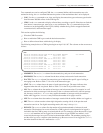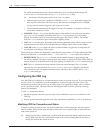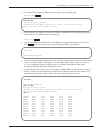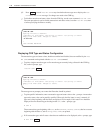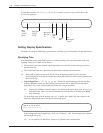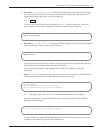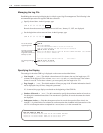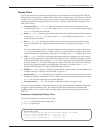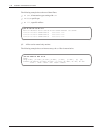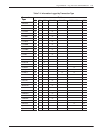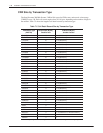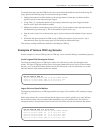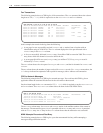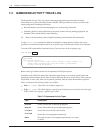
Log
Commands — Log, List Trace, Call Detail Record 7-33
Octel Overture 200/300 Serenade 3.0
PB60014–01
Display Filters
You
can use seven filters to define specifically the type of information that is displayed in the CDR log.
Multiple filters can be used in a command line, but each filter can appear only once. However
, if only the
first letter or two of the transaction type or status value is entered, all transaction types or status values
beginning with the letter entered are filtered. If no filter is specified, all information is displayed. The
filters are as follows:
- T
ransaction T
ype,
XA [XACTIN].
Enter the transaction type that should be displayed. In the
command string, type
XA [type].
For example, type
XA NTMSGD
for network messages send day
,
or XA NT
for all network transactions.
-
Status,
ST [STAT].
Enter the type of status information that should be displayed. In the command
string, type
ST [status].
For example, enter
ST FLLQ
for failed line-quality test or
ST FL for
all network-failure conditions.
-
Port,
PR [PRT].
If a specific port should be displayed, enter that port number in the command
string. The designation of a single port number must consist of three digits (for example,
005 for
Port 5).
For ports numbered above 9, the 2-digit port number should be preceded by a single 0 (for example,
023
). For ports numbered above 9, a range of 10 ports can be specified by entering the 0, plus one
significant number for the beginning of the range. For example, type
PR 03
to display ports 30–39.
-
COS,
CO [COS].
The COS of the incoming port/trunk group for an integrated-call record can be
displayed. The designation of a single COS must consist of 3 digits. For COS 1 through 9, the COS
should be preceded by 00 (for example,
001
). For COS 10 through 99, the COS should be preceded
by 0 (for example,
037
). For COS 10 through 99, a range of ten COSs can be specified by entering
the 0 plus one significant number for the beginning of the range. For example, type
CO 09
to
display COS 90 through 99. T
o display COS 100 through 199, enter
1.
-
Mailbox,
MA [MBX].
Specific or partially specified mailbox number prefixes can be displayed. For
example, to display all mailboxes that start with 43, type
MA
43.
-
Messages Sent,
MS [MS].
W
ith this filter
, the number of messages sent during a transaction can be
defined. For example, if abandoned calls for a specific transaction type should be displayed, specify
MS 00.
All calls with 0 messages left would be displayed.
-
Messages Erased,
ME [ME].
Use this filter to define the number of messages erased.
All records contain information about transaction type, status, port and duration. Additional information
is logged for specific transaction types. The settings included in this information are defined at the
beginning of this section. A matrix of which settings apply to which transaction types is presented in
T
able 7-4.
Examples of Using Multiple Display Filters
The
following example shows the use of two filters:
- XA CAL,
all transaction types starting with
CAL
- PR
009
, a specific port
@CDR XA CAL PR 009
MM/DD/YY HH:MM:SS XACTIN STAT MS ME PRT DURATN MAILBOX COS CALLER
11/22/97 12:04:55 CALMBX GRET 00 009 0:00.1 7777
*11/22/97 12:05:14 CALFLX QUE 00 009 0:00.3 8103
11/22/97 12:12:13 CALMBX BUSY 01 009 0:01.5 4319



